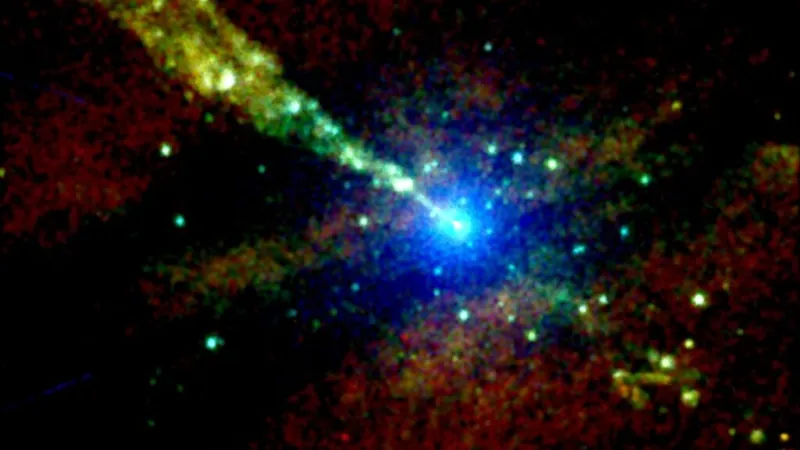
NASA's Chandra X-ray Telescope Unveils Fascinating Black Hole Jet 'Knots' in a Groundbreaking Discovery
2024-11-06
Author: Jia
Groundbreaking Discovery of Black Hole Jets
Astronomers have made a stunning breakthrough using data from NASA's Chandra X-ray Observatory, revealing brilliant, irregular features known as "knots" that are erupting from the jets of a nearby supermassive black hole. These findings, which were shared in a study published on October 18 in The Astrophysical Journal, have sparked new excitement within the astrophysics community and raised critical questions about the behavior of cosmic jets.
New Insights from X-ray Data
The lead author of the study, David Bogensberger, an astrophysicist at the University of Michigan, explained in a recent statement, "The X-ray data provides a unique view that other wavelengths cannot capture. This new approach to studying jets opens a plethora of intriguing avenues for future research." Astonishingly, these X-ray knots appear to be moving at speeds that are 14% faster than when they are observed in radio wavelengths, creating a perplexing puzzle for scientists to investigate.
NASA's Challenges and Future of Chandra
This significant discovery comes at a time of uncertainty for Chandra, as NASA grapples with ongoing budget constraints that could lead to potential cuts. The telescope, which has been operational for over 25 years, celebrated its anniversary in July, yet the agency's financial status has left its future hanging in the balance. The agency remains in a holding pattern, operating on prior budget levels as the outcome of the upcoming presidential election will significantly influence funding decisions for 2025 and beyond.
Study Findings on Centaurus A
In the study, Bogensberger and his team meticulously analyzed two decades of Chandra's observations focusing on Centaurus A—a peculiar galaxy approximately 12 million light-years from Earth. One of the newly identified jet knots seems to be traveling at an incredible 94% of the speed of light, presenting a marked difference from the 80% speed observed in radio frequencies.
Complexity of Black Hole Jets
Bogensberger elaborated, "The differing speeds of the knots in radio and X-ray bands highlight our lack of understanding about how these jets function in the X-ray spectrum." This emphasizes the complexity of black hole jets and raises questions about the magnetic forces at play around these cosmic giants, as well as the role of their rotation in funneling material.
Historical Context of Centaurus A
Centaurus A has been intriguing astronomers since its discovery in the mid-1800s, but its twin jets were only mapped out a century later with the advent of new radio telescope technology. Notably, one jet stretches toward Earth while its fainter counterpart points in the opposite direction.
Understanding Black Hole Jet Dynamics
The dynamics of how these jets operate remain largely elusive. Black holes draw in material from their surroundings, which is then expelled in jets before it can cross the event horizon—a point of no return. Theories suggest that chaotic magnetic fields and the spin of the black hole could play significant roles in this process.
Observations of Varying Brightness
What further complicates the puzzle is the observation of the knots' varying brightness over the years. From 2002 to 2022, some knots intensified while others dimmed, mirroring past observations of jets from the M87 galaxy, which resides about 55 million light-years away in the constellation Virgo. The reasons behind these fluctuations are yet to be fully understood but could be tied to external interstellar materials or intrinsic jet behaviors.
Future Studies and Expectations
As astronomers prepare for further studies of Centaurus A and other galaxies, they hope to unravel the mysteries of jet dynamics and the environmental factors influencing their behavior. Bogensberger noted, "Understanding how different wavelength bands relate to various aspects of the environment will be crucial in deciphering what's truly happening in these jets. We're just starting to explore that possibility."




 Brasil (PT)
Brasil (PT)
 Canada (EN)
Canada (EN)
 Chile (ES)
Chile (ES)
 España (ES)
España (ES)
 France (FR)
France (FR)
 Hong Kong (EN)
Hong Kong (EN)
 Italia (IT)
Italia (IT)
 日本 (JA)
日本 (JA)
 Magyarország (HU)
Magyarország (HU)
 Norge (NO)
Norge (NO)
 Polska (PL)
Polska (PL)
 Schweiz (DE)
Schweiz (DE)
 Singapore (EN)
Singapore (EN)
 Sverige (SV)
Sverige (SV)
 Suomi (FI)
Suomi (FI)
 Türkiye (TR)
Türkiye (TR)